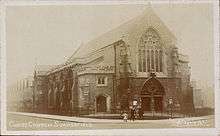Christ Church, Summerfield
| Christ Church | |
|---|---|
 | |
| 52°28′56.6″N 1°56′20.8″W / 52.482389°N 1.939111°WCoordinates: 52°28′56.6″N 1°56′20.8″W / 52.482389°N 1.939111°W | |
| Location | Summerfield, Birmingham |
| Country | England |
| Denomination | Church of England |
| Website |
www |
| History | |
| Dedication | Christ Church |
| Consecrated | 30 April 1885 |
| Architecture | |
| Heritage designation | Grade II listed |
| Architect(s) | J. A. Chatwin |
| Style | Perpendicular |
| Groundbreaking | 1883 |
| Completed | 1885 |
| Administration | |
| Parish | Summerfield |
| Deanery | Edgbaston |
| Archdeaconry | Birmingham |
| Diocese | Anglican Diocese of Birmingham |

Christ Church is a Grade II listed parish church in the Church of England in the Summerfield district of Birmingham.[1][2]
History
The foundation stone was laid in November 1883 by the widow of Revd George Lea, vicar of St George's Church, Edgbaston. The church was built between 1883 and 1885 in a Perpendicular Style to designs by the architect J.A. Chatwin.[3] It was consecrated on 30 April 1885.
A parish was created out of the parish of St John's Church, Ladywood.[4] In 1906 part of the parish was transferred to St Augustine's Church, Edgbaston.
Organ
The organ was installed by Nicholson and Co in 1889. A specification of the organ can be found on the National Pipe Organ Register.[5]
The community today
As of 2016, Christ Church serves a diverse, urban population of about 10,500 people. The worshipping community is a diverse group of 70 adults and 30 or so young people under the age of 18. As of 2016, the congregation worships in the adjacent hall while plans are made for the refurbishment and reordering of the church building.
References
- ↑ The Buildings of England. Warwickshire. Nikolaus Pevsner. Penguin Books. ISBN 0140710310 p.210
- ↑ Historic England. "Details from listed building database (1076167)". National Heritage List for England.
- ↑ "Christ Church, Birmingham". British Listed Buildings. britishlistedbuildings.co.uk. Retrieved 22 February 2015.
- ↑ Victoria County History: History of the County of Warwick. Volume 7: City of Birmingham 1964. p.382
- ↑ "NPOR N07298". National Pipe Organ Register. British Institute of Organ Studies. Retrieved 22 February 2015.